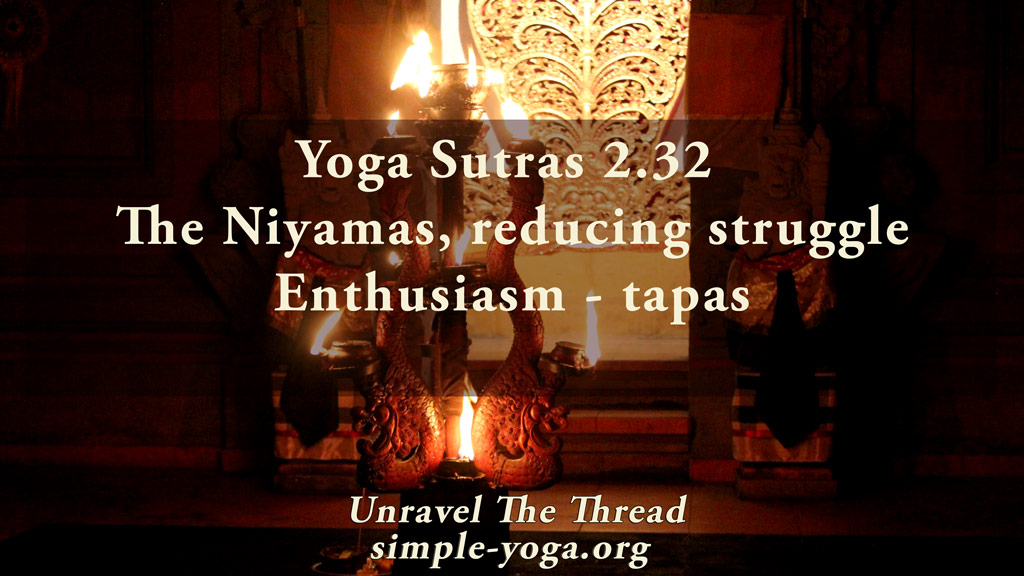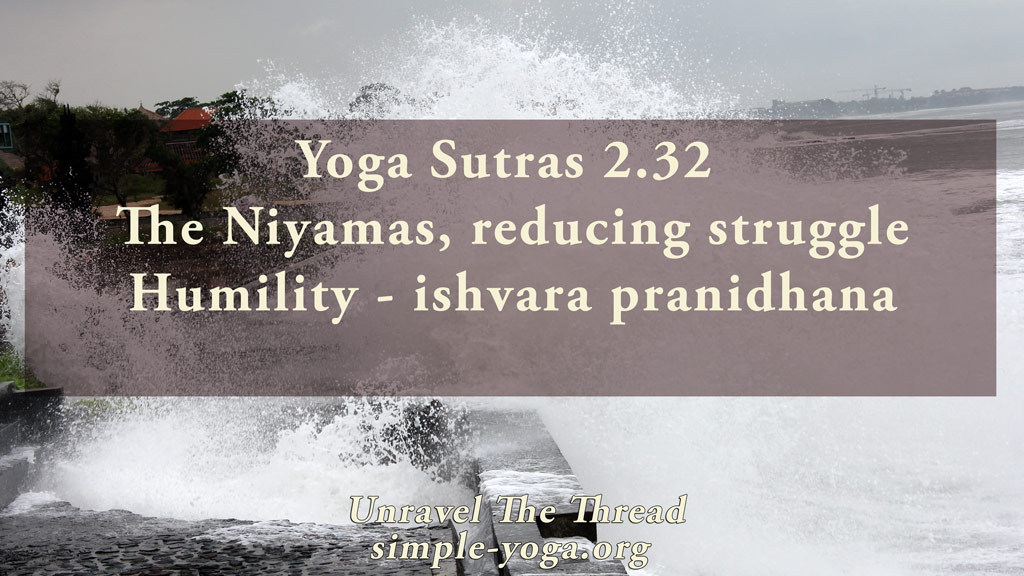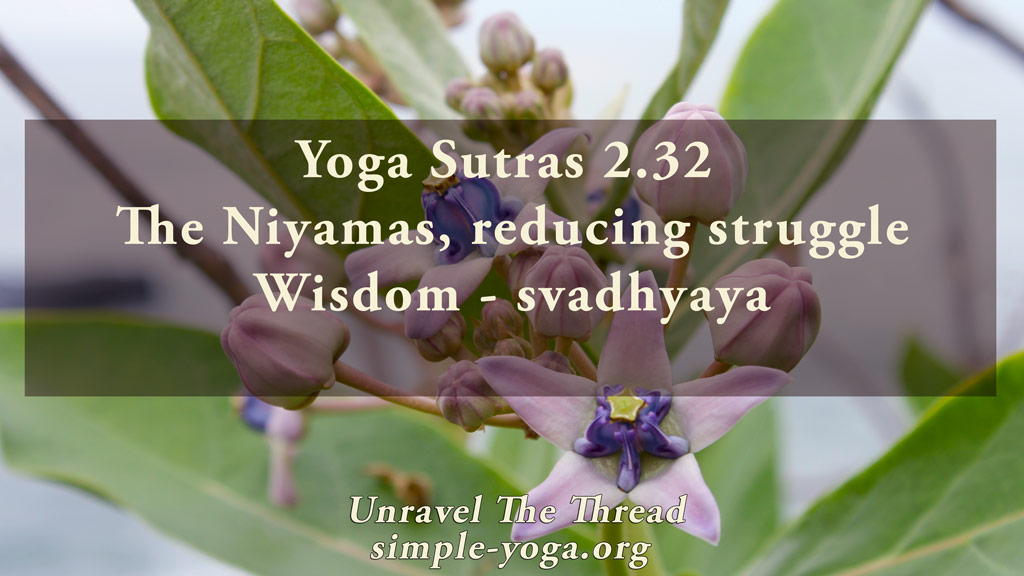
2.32 Niyamas: Enthusiasm – tapas
November 2, 2020
2:32 Niyamas: Humility – ishvara pranidhana
December 1, 2020
2.32 Niyamas: Enthusiasm – tapas
November 2, 2020
2:32 Niyamas: Humility – ishvara pranidhana
December 1, 20202.32 Niyamas: Wisdom – svadhyaya

The meanings of the Sanskrit word svadhyaya include to read, to study, to recite, to study true wisdom, as well as self-study. In all the traditions of the world, there is a body of useful and practical wisdom that is transmitted down from generation to generation to ensure that new generations benefit from the discoveries of their ancestors to live a healthy, meaningful and joyful life. Since everything is in continuous change, this body of knowledge evolves over time to remain relevant for understanding ourselves and the world around us. Wisdom, understood as pure common sense, is instrumental to your most important duty: your wholehearted and open-minded participation in life’s perfection. Fortunately, now it is possible to find wisdom that has been distilled over generations by different human groups. It is important to recognize that wisdom is not dogmatic. In fact, wisdom shows its usefulness in its direct application into your life. Otherwise, wisdom can become just a new story to entertain your mind.
Knowing yourself, knowing your tendencies and patterns is essential in order to recognize how those patterns influence the quality of your participation in your life. Without knowing your ways of being you are at the mercy of those patterns without really understanding why some obstacles keep appearing along your path. Similarly, it may be difficult to harness useful ways of being to enhance your experience. For instance, all of us develop postural and movement patterns. Some of those patterns compensate for the natural asymmetries of each person’s body. Other patterns respond to some tendencies in us. The patterns in themselves are not necessarily good or bad. Noticing the effects of the patterns can help you decide if the pattern is currently serving a purpose. For instance, most of us will tend to use one hand to hold our toothbrush when brushing our teeth. We do not even think about it. The pattern becomes very familiar, and it may make it easier to not focus fully on the task of brushing our teeth. When you try to do the same task holding the toothbrush with your non-dominant hand you notice how unfamiliar and awkward it feels to try to brush your teeth. That awkwardness is likely the result of noticing lack of coordination or skill. However, you can train yourself to use your non-dominant hand and, over time, you will develop more familiarity and dexterity. Choosing to use your non-dominant hand can be an effective way to draw your attention to the task. It may also give you insight into the process, helping you expand your perception and awareness. Besides, by using your non-dominant hand you may expand the repertoire of options available to you.
Engaging in self-inquiry, that is, when you explore yourself with genuine curiosity, you come to recognize that you have never been in a vacuum. You have never been isolated from the world around you. In fact, you eventually realize that everything that you can perceive is connected to you either directly or indirectly, because you are deeply embedded in the universe. And, just like solar flares influence the electromagnetic fields of the earth and the moon influences ocean tides, everything that is happening around you and within you contributes to the ongoing movement of life inside and outside of you. Engaging in svadhyaya means cultivating a healthy curiosity about yourself so that you can see clearly how your habit patterns and tendencies may influence your thoughts, moods, motivations, breath, posture, movement, and actions. Keep in mind that some patterns may be useful in one context and unhelpful in another context. This healthy curiosity includes studying and trying to put into practice true wisdom. Some questions to guide your exploration:
How well do you know yourself?
What are the stories that you choose to believe and perpetuate?
How do you know if those stories are true wisdom?
What patterns do you notice in your ways of thinking, ways of breathing, ways of feeling, and ways of moving?
Which of these patterns are helpful and which are unhelpful?
In what context is one pattern helpful and in what other contexts unhelpful?
To what extent can you modulate these patterns?
You may also use the mantra, I KNOW MYSELF THOROUGHLY to maintain your commitment to self-study.
As usual, one more way of exploring the meaning of this sutra is by chanting it.
You can choose to chant it in its traditional form with some of the words coming together:
2.32 śauca saṃtoṣa tapaḥ svādhyāyeśvarapraṇidhānāni niyamāḥ
शौच संतोष तपः स्वाध्यायेश्वरप्रणिधानानि नियमाः ॥३२॥
Another option is to chant each word in the sutra individually:
- śauca
- saṃtoṣa
- tapaḥ
- sva
- adhyāya
- iśvara
- praṇidhānāni
- niyamāḥ
If you prefer, you may listen to the podcast:
Unravel the thread is now available as a book!
If you find Simple-Yoga.org and Unravel the thread useful, consider supporting my labor with a donation, you may also donate using PayPal or Venmo. Thank you!
